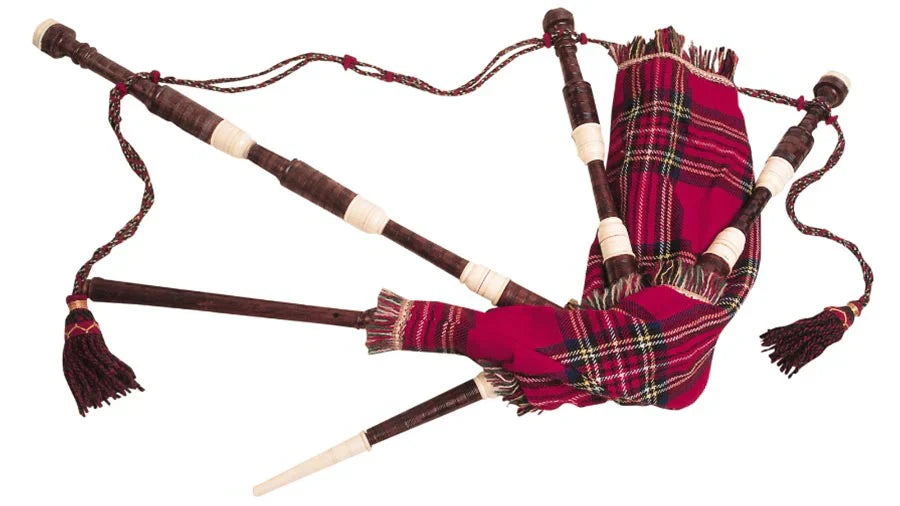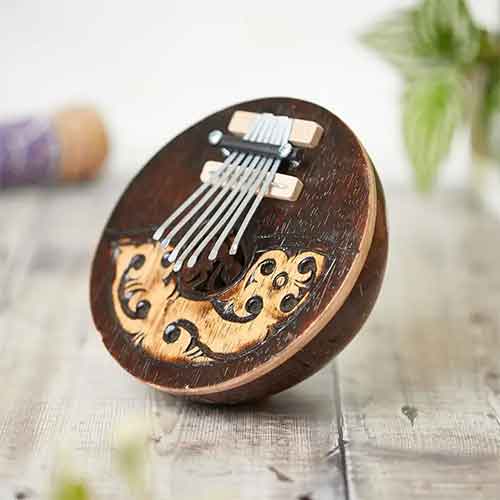Bagpipes are complex musical instruments with origins in Scotland. Known for their unique sound and playing method, they stand out from other instruments. In this article, we will explore the anatomy of bagpipes, examining the various parts that make up this ancient instrument. Learning to play the bagpipes can be both challenging and rewarding. This guide will also walk you through the steps to get started, from selecting a good instructor to choosing the right practice chanter and tutor books.
Anatomy of the Bagpipes

Bagpipes consist of four main sections: the blowstick, the bag, the drones, and the chanter reed. While there may be some variations in different types of bagpipes and cultures, these sections encompass all the smaller components.
The Blowstick
The blowstick is essentially the mouthpiece of the bagpipe and is used to blow air into the bag, creating the pressure necessary to produce sound. The blowstick attaches directly to the bag and features a special valve that allows air to enter but prevents it from returning up the blowstick. Positioned at the top of the bag, the blowstick rests near the player's mouth when the instrument is upright. This requires incredible endurance and breath control. While modern bagpipes often use high-quality plastic blowsticks, traditional materials such as wood are still favoured by serious and professional players.
The Bag

The bag is the most significant part of the bagpipe and serves as the base to which all other parts attach. The bag is traditionally made from sheepskin or cowhide, as these materials provide an airtight seal and inflate on command. However, synthetic rubber-like materials are commonly used today due to their similar qualities and increased durability. The size, material, and shape of the bag affect how easy it is to play, as players need to apply varying degrees of pressure to maintain correct notes while playing.
The Drones
Scottish bagpipes typically have three drones: the bass drone and two tenor drones. These drones determine the pitch and tone of the instrument and are made of bamboo or similar wood. The drones have small holes where air escapes at the tips. By applying pressure to different areas of the bag, players can control the airflow and produce varying sounds.
Bass Drone

The bass drone is the largest drone attached to the bagpipe. It produces the lower humming characteristic that is often associated with bagpipe music. The bass drone is located closest to the player's face, next to the blowstick. It is held in place using the bass hole on the bagpipes.
Tenor Drones
Bagpipes also feature two tenor drones, which are smaller than the bass drone and located further down the bag. Like the bass drone, the tenor drones are made from bamboo and control the higher-pitched humming sound that complements the notes produced by the bass drone.
Tuning Slides

Each drone on the bagpipes has a small ring called a tuning slide. These slides can be moved up and down to adjust the instrument's tuning. While tuning slides are typically made of wood, older bagpipes may feature decorative materials such as silver or ivory. Skilled bagpipers may even adjust the tuning of the instrument mid-song to achieve the desired sound.
Drone Cords
Drone cords with the traditional Scottish red plaid, are seemingly decorative tassels attached to the bass drone and tied along the shaft of each tenor drone. However, their purpose goes beyond aesthetics. Drone cords provide stability, preventing the drones from jostling the player as they move and play the bagpipes.
The Chanter

The chanter is the part of the bagpipes that produces the melody. It is held under the player's arm while both hands manipulate the holes along its shaft to make different notes. The chanter is sometimes called the pipe chanter and operates similarly to a clarinet. Air passes through the chanter reed, hidden between the pipe chanter and the bag, to produce the sound that emanates from this crucial component of the bagpipes.
Chanter Reed
The chanter reed is a vital part of the bagpipes, responsible for producing the sound heard from the chanter. It consists of two bamboo slivers that allow pressurisedpressurised air from the bag to pass through. The chanter reed is tucked away between the pipe chanter and the bag, hidden from sight but playing a crucial role in creating the distinctive sound of the bagpipes.
The bagpipes are a complex and impressive instrument with a rich history. Understanding the different parts of a bagpipe, from the blowstick and bag to the drones and chanter, provides insight into the engineering and craftsmanship behind this ancient instrument. Whether you are a bagpipe player or fascinated by music, exploring the anatomy and structure of bagpipes deepens your appreciation for this unique instrument.
How to Play the Bagpipes - Tutorial

The Importance of a Good Instructor
Learning to play the bagpipes is not something you can easily pick up on your own. It requires proper guidance and instruction from a knowledgeable teacher. While it's preferable to start learning as a child or teen, adults with patience, perseverance, and dedication can also excel. If you don't have a good instructor near you, don't worry. Many instructors offer online lessons, allowing you to learn from the comfort of your own home. Additionally, attending workshops and summer schools can provide valuable opportunities to enhance your skills and connect with other pipers.
Time Commitment: Practice Makes Perfect
To make progress and master the bagpipes, you must be prepared to dedicate a significant amount of time to practice. Aim for a minimum of 25 minutes of focused practice per day, at least five days a week. However, if you can devote an hour a day, six days a week, you'll see even more remarkable improvement. Remember, talent alone is not enough; consistent practice is crucial. Treat your practice sessions seriously and avoid distractions whilst playing, such as scrolling through your phone or watching television. The more you practice, the faster you will advance.
Getting Started: The Practice Chanter
Before you start playing the bagpipes themselves, you should start your journey with a practice chanter. A practice chanter is a small oboe-like instrument that serves as a precursor to the complete set of bagpipes. It allows you to learn the fingerings and grace noting system required to play Highland bagpipe tunes. Practice chanters come in different materials, including polypenco (plastic) and wooden options. The choice between the two depends on your preference and budget.
Choosing a Practice Chanter
When selecting a practice chanter, you have several options to consider. Polypenco practice chanters are affordable and durable, making them ideal for beginners. They typically cost between $75 and $175. On the other hand, wooden practice chanters, often made from African Blackwood, offer a more vibrant sound. However, they come at a higher price, ranging from $175 to $400 and beyond for those with silver or engraved details. Beginners usually start with a regular-sized chanter, but there are also smaller chanters available for younger children.
Where to buy bagpipes?
Tutor Books: Your Guide to Learning
Alongside your practice sessions, it's essential to have a beginner tutor book. There are several excellent options available, each with its unique teaching approach. The College of Piping Tutor, or the "Green Book," is a popular choice, especially when learning with an instructor. First published in 1953, it has become the best-selling piping book worldwide. It offers online video demonstrations to assist with exercises and tunes. The Highland Bagpipe Tutor Book by The National Piping Centre is another valuable resource, particularly if you don't have regular access to an instructor. It includes a CD-ROM for additional learning support. Additionally, Rhythmic Fingerwork, a widely acclaimed instructional book, focuses on mastering the intricate grace noting required in Highland pipe tunes. While not a beginner tutor, it can be beneficial after a few months of practice.
Starting Your Bagpipe Journey
Now that you understand the key components needed to learn the bagpipes, it's time to take the first steps. To get started, focus on acquiring the essentials, such as a practice chanter and tutor books. These are fundamental tools for building a strong foundation. You don’t need a full set of bagpipes right away. Start by learning to use the practice chanter to develop your skills before progressing to the full instrument.
Additional Resources and Support
Learning to play the bagpipes is a journey that requires ongoing support and resources. Apart from your instructor and tutor books, other tools can assist you. Online forums and communities dedicated to bagpipes provide the opportunity to ask questions and seek advice.
Attending piping competitions and festivals can inspire and motivate you to continue honing your skills. Get involved in the bagpiping community and connect with fellow pipers who can offer guidance and encouragement. Learning to play the bagpipes is a rewarding endeavour that requires dedication, patience, and the right resources. With a good instructor, regular practice, and the right tools, you can make remarkable progress on this distinctive instrument.













